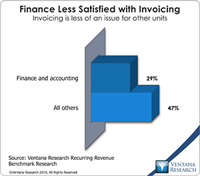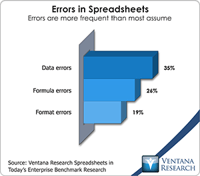Revenue recognition standards for companies that use contracts are in the process of changing, as I covered in an earlier perspective. As part of managing their transition to these standards, CFOs and controllers should initiate a full-scale review of their order-to-cash cycle. This should include examination of their company’s sales contracts and their contracting process. They also should examine how well their contracting processes are integrated with invoicing and billing and any other...
Read More
Topics:
Planning,
Governance,
Office of Finance,
Recurring Revenue,
Reporting,
Revenue Performance,
Budgeting,
Tax,
Business Performance,
Financial Performance
For most of the past decade businesses that decided not to pay attention to proposed changes in revenue recognition rules have saved themselves time and frustration as the proponents’ timetables have slipped and roadmaps have changed. The new rules are the result of a convergence of US-GAAP (Generally Accepted Accounting Principles – the accounting standard used by U.S.-based companies) and IFRS (International Financial Reporting Standards – the system used in much of the rest of the world)....
Read More
Topics:
Planning,
Customer Experience,
Governance,
Office of Finance,
Recurring Revenue,
Reporting,
Revenue Performance,
Budgeting,
Tax,
Customer Performance,
Business Performance,
Financial Performance
Price and revenue optimization (PRO) software uses analytics to help companies maximize profitability for any targeted level of revenues. PRO utilizes data about buyer behavior to gauge individual customers’ price sensitivity and predict how they will react to prices. It enables users to charge buyers who appear to be less sensitive more than those who appear more price-sensitive. PRO is a significant departure from inward-focused, single-factor pricing strategies such as cost-plus pricing or,...
Read More
Topics:
Office of Finance,
Revenue Performance,
Nomis Solutions,
Business Performance,
Financial Performance,
Financial Services
NICE Systems last week announced an agreement to acquire Merced Systems, a provider of business applications for customer service and sales organizations. This acquisition slipped by with little fanfare, but it marks a significant milestone for NICE, a major provider of applications and technology for call centers and a player in their evolution into multichannel contact centers. Building on a good 2010, as my colleague Richard Snow noted, NICE expects to reach almost $800 million of revenue in...
Read More
Topics:
Predictive Analytics,
Sales,
Sales Performance,
Social Media,
Customer Analytics,
Customer Data Management,
Customer Experience,
Customer Feedback Management,
Marketing,
Merced Systems,
NICE Systems,
Revenue Performance,
Sales Compensation,
Sales Force Automation,
Social CRM,
Speech Analytics,
Voice of the Customer,
Operational Performance,
Analytics,
Business Analytics,
Business Collaboration,
Business Mobility,
Business Performance,
Cloud Computing,
Customer & Contact Center,
Customer Service,
Financial Performance,
Workforce Performance,
Call Center,
CFO,
CMO,
Contact Center,
Contact Center Analytics,
CRM,
Desktop Analytics,
Sales Performance Management,
SFA,
Text Analytics,
Unified Communications,
Workforce Management
Sales organizations strive to maximize the performance of their staffs to meet quotas and revenue targets in an efficient manner. This focus is part of my agenda to help organizations innovate and maximize revenue in sales. To achieve this requires automation of various sales activities including compensation, incentives, quota development, territory optimization, channel management, analytics and planning. Varicent is focused on these aspects of sales, offering software deployable in three...
Read More
Topics:
Sales,
Sales Performance,
Social Media,
Marketing,
Revenue Performance,
Sales Force Automation,
Sales Operations,
Operational Performance,
Business Analytics,
Business Collaboration,
Business Mobility,
Business Performance,
Cloud Computing,
Customer & Contact Center,
Financial Performance,
Workforce Performance,
CFO,
CMO,
CRM,
Sales Performance Management,
SFA,
Varicent
Salesforce.com’s 2011 Dreamforce conference is under way. If you’re in sales and you use the company’s application, here’s how to gain the most value from your time at the conference.
Read More
Topics:
Sales,
Sales Performance,
Salesforce.com,
Social Media,
Marketing,
Marketo,
Merced Systems,
Qvidian,
Revenue Performance,
Sales Force Automation,
Sales Operations,
Zilliant,
Zyme Solutions,
Operational Performance,
Business Analytics,
Business Collaboration,
Business Mobility,
Business Performance,
Cloud Computing,
Customer & Contact Center,
Financial Performance,
Workforce Performance,
Callidus Software,
Camelon Software,
CFO,
ChannelInsight,
Cloud9 Analytics,
CMO,
CRM,
Sales Performance Management,
SFA,
Varicent,
Vendavo,
Xactly
In addressing the needs of their sales and operations teams to automate and improve performance, many organizations turn to providers of sales applications designed for specific activities. Many of these activities, including sales compensation, incentives, commissions, quotas, territories and others, Xactly has been delivering for years. This company is no newcomer to the market, with significant experience in meeting the needs of small to midsize sales organizations, and more recently...
Read More
Topics:
Sales,
Sales Performance,
Social Media,
Marketing,
Revenue Performance,
Sales Force Automation,
Operational Performance,
Business Analytics,
Business Collaboration,
Business Mobility,
Business Performance,
Cloud Computing,
Customer & Contact Center,
Financial Performance,
Workforce Performance,
CFO,
CMO,
CRM,
Sales Performance Management,
SFA,
Xactly
Looking to make your sales force more effective by automating its operations? Merced Systems can provide the traction your sales team needs. The company has been providing applications for more than a decade to customer service and more recently sales organizations, helping both measure and manage performance. Several years ago Merced Systems made a substantial investment to expand to the sales organization with new applications and now offers analytics and reporting, compensation and...
Read More
Topics:
Sales,
Sales Performance,
Social Media,
Marketing,
Merced Systems,
Revenue Performance,
Sales Compensation,
Sales Force Automation,
Operational Performance,
Business Analytics,
Business Collaboration,
Business Mobility,
Business Performance,
Cloud Computing,
Customer & Contact Center,
Financial Performance,
Workforce Performance,
CFO,
CMO,
CRM,
Sales Performance Management,
SFA
If you want to hit the booking and revenue targets required to operate a business, you have to manage your sales forecast and pipeline. Optimally you should be able to monitor and act upon them any day of the week and make adjustments whenever you need to. Unfortunately, most organizations have to wait until they finish their manual efforts at the end of the month or quarter, or they miss critical changes in deals and behavior because they rely only on reporting from their sales force...
Read More
Topics:
Sales,
Sales Performance,
Salesforce.com,
Social Media,
Marketing,
Revenue Performance,
Sales Force Automation,
Sales Forecasting,
Sales Operations,
Operational Performance,
Business Analytics,
Business Collaboration,
Business Mobility,
Business Performance,
Cloud Computing,
Customer & Contact Center,
Financial Performance,
Workforce Performance,
CFO,
Cloud9 Analytics,
CMO,
CRM,
Sales Performance Management,
SFA
The largest cloud computing conference, Dreamforce 2011, operated by Salesforce.com, is now upon us. This year attendance is estimated to be over 40,000, and there will be more technology- and developer-focused attendees and dialogue than marketing material. Unlike past years, I expect marketing professionals to be a small percentage of attendees, so I thought I would offer them a guide through the circus of activities at the conference.
Read More
Topics:
Sales Performance,
Salesforce.com,
Social Media,
ExactTarget,
HubSpot,
Manticore Technology,
Marketing,
Marketing Automation,
Marketing Planning,
Marketo,
Pardot,
Revenue Performance,
Sales Force Automation,
Operational Performance,
Business Collaboration,
Business Mobility,
Business Performance,
Cloud Computing,
Customer & Contact Center,
Financial Performance,
IBM,
CFO,
CMO,
CRM,
Demand Generation,
Eloqua,
SFA,
Unica,
Digital Technology











